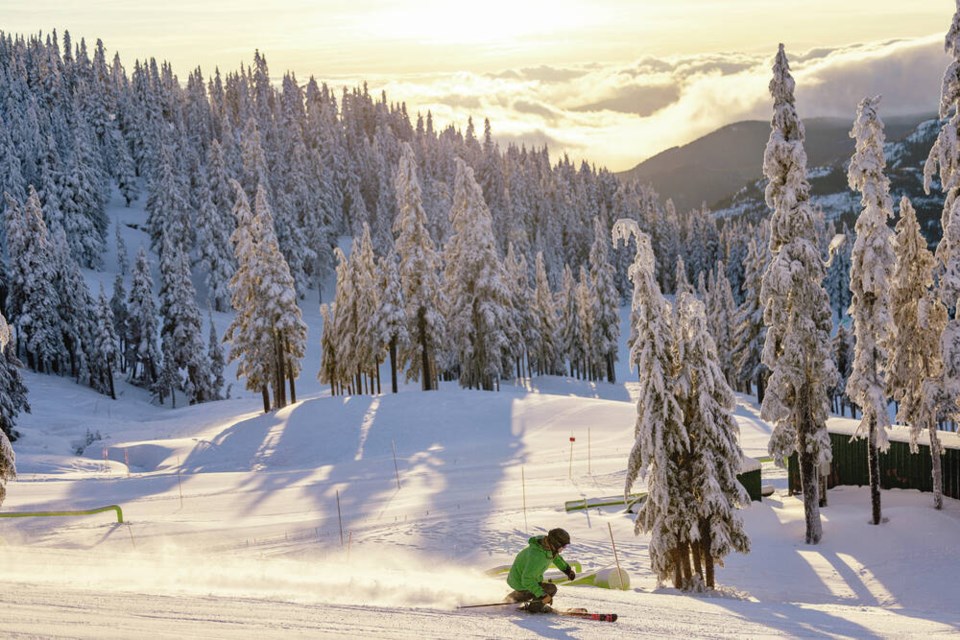It’s not time to sell your skis and snowboards just yet, but the days of coastal ski resorts may be numbered, says an academic who studies how climate change affects ski resorts.
Resorts across B.C. are off to a rough start this ski season, with unusually low snowfall so far, but ski resorts on the south coast are struggling more than most, said Michael Pidwirny, an associate professor in earth, environmental and geographic sciences at the University of British Columbia’s Okanagan campus.
The average winter temperature at coastal resorts is close to zero degrees, so any unseasonable warmth tends to decrease snowfall, he said.
Mount Washington launched its season on Dec. 8 with just one chairlift open, providing access to three or four runs, said the resort’s marketing manager Kayla Stockton. It has since opened two more chairs, but many runs remain closed.
On Friday afternoon, the resort was reporting a 40-centimetre snowbase, about 37 per cent of its average snow depth for the past 10 years, according to data compiled by On The Snow magazine.
Snow was in the forecast for Friday, although the amount of snow predicted for the day had dropped from 33 centimetres earlier in the week to 14 by Friday afternoon.
Other coastal resorts are similarly lacking snow. Mount Seymour on Vancouver’s North Shore was temporarily closed last week and again this Thursday and Friday. A statement on the resort’s website said it was pausing operations as it waited for more snowfall and conditions to improve.
Photos on social media of grassy runs with patches of snow at Whistler Blackcomb show the struggles of North America’s largest ski resort, where just 61 per cent of skiable terrain was open as of Friday.
The warm winter is blamed on the return of El Niño, which brings warmer-than-average temperatures and less precipitation. The oceanic phenomenon can last up to three years, Pidwirny said. The last time B.C. was affected by El Niño was in 2015 and 2016, he said.
“This is probably the most severe El Niño for the last 50 years,” Pidwirny said. It brought record high temperatures to several coastal communities in December, including Victoria, Comox and Campbell River.
Another factor that influences snowfall and temperatures is what’s called the Pacific Decadal Oscillation, which alternates between a warm or cold state, Pidwirny said. B.C. is currently in the cold phase.
The last warm phase of the effect was from 2013 to 2016, and it was known colloquially as The Blob, he said.
Next winter could be worse for skiers and snowboarders if the Pacific Decadal Oscillation swings to the warm phase, Pidwirny said. Scientists will be able to predict what phase B.C. will be facing for the winter by this summer, he said.
The next few weeks will likely bring a cold spell and better skiing conditions, before a return to warm, dry weather, Pidwirny said.
“February and March are going to be pretty nasty for the ski resorts,” he said.
A skier himself, Pidwirny said he decided not to buy a season’s pass this year for his local resort, Big White near Kelowna, but he emphasized that a bad season or two doesn’t mean B.C. skiing is on its way out.
He notes that seven years of excellent skiing conditions followed three bad years until the 2015-2016 season.
Those challenging seasons led Mount Washington to install snow-making machines in the 2019-2020 season, Stockton said.
Nonetheless, with increased greenhouse-gas emissions and global temperatures rising, coastal ski resorts could become a thing of the past by 2050, Pidwirny said. Even Whistler, which is at a higher elevation, “could be toast” by 2085, he said.
>>> To comment on this article, write a letter to the editor: [email protected]



